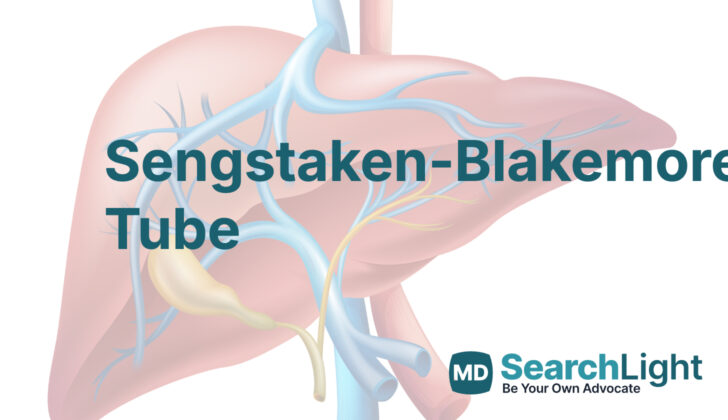Overview of Sengstaken-Blakemore Tube
In 1950, Robert W. Sengstaken and Arthur H. Blakemore noticed the life-saving potential of blood banks. They could efficiently deliver large volume of blood to patients, especially those bleeding from swollen veins in their esophagus, also known as esophageal varices. But, simply giving blood wasn’t enough, especially for patients with liver cirrhosis – often associated with frail and easily damaged livers. Even though blood transfusions helped initially, several patients died of liver failure days later.
Looking at recent developments in managing stomach ulcers that reduced deaths dramatically, Sengstaken and Blakemore thought of a way to stop the bleeding from varices. Their aim was to reduce total blood loss, protect vital organs from shock, and postpone fatalities. However, there were no existing equipment to plug, or “tamponade”, these esophageal varices. They used data from experiments measuring blood pressure in the portal vein – a major vein leading to the liver. This gave them insights about the amount of pressure needed to squeeze shut the blood vessels around the heart and esophagus(and also how much pressure the esophagus could handle safely).
Based on this information, they invented the Sengstaken-Blakemore tube. While seldom utilized today, it may come handy in cases when the go-to treatment doesn’t work. Generally, a specialist in digestive system diseases, or a gastroenterologist, conducts a procedure called endoscopy for both diagnosing and treating heavy bleeding from varices. The usual treatment is endoscopic band ligation, but sclerotherapy can also be an option. Sadly, even when done in a facility with an available gastroenterologist, these methods don’t always work. When that happens, the balloon tamponade technique using the tube Sengstacken and Blakemore created might save lives by temporarily controlling the bleeding.
Anatomy and Physiology of Sengstaken-Blakemore Tube
Esophageal varices often occur as a result of liver cirrhosis, which is when the liver gets damaged and scarred. This scarring can lead to the blood vessels becoming squeezed and blocked, causing what is known as portal hypertension. In simple terms, portal hypertension is a condition where there’s high blood pressure in the liver’s blood vessels. This causes an increase in pressure in the veins of the esophagus and stomach.
This high pressure can lead to the formation of varices, which are large, swollen veins. Particularly, these varices can develop in the veins beside the esophagus, which get their blood supply from the azygos vein, and in the short veins of the stomach that receive blood from the splenic vein.
Why do People Need Sengstaken-Blakemore Tube
A Sengstaken-Blakemore tube, a device used to stop bleeding, is a practical solution when a patient is in a critical situation with uncontrolled bleeding. This can be the case if an endoscopic procedure – a way to see inside your body using a flexible tube with a camera on the end – is unavailable or has been unsuccessful. Those living in remote rural areas may also need this device if they don’t have immediate access to specialist doctors.
Essentially, the tube serves as a temporary fix to control the bleeding and stabilize the patient until they can be moved to a healthcare facility that provides a more comprehensive care. However, it is important to remember that this is not a permanent solution. While initial bleeding may be halted by the device’s balloon tamponade (a method to control bleeding by applying pressure), more than half of the patients usually experience bleeding again once the device is removed. This is why it is crucial to seek a definitive treatment after the use of a Sengstaken-Blakemore tube.
When a Person Should Avoid Sengstaken-Blakemore Tube
In simple terms, there are certain situations where placing a Sengstaken-Blakemore tube could be risky. These situations include if the patient has a known narrowing (stricture) of their food pipe (esophagus), or if they had recent surgery on their esophagus or stomach. These conditions can make the patient more likely to suffer from a tear or rupture in the esophagus.
However, it’s essential to note that placing a Sengstaken-Blakemore tube is a treatment usually considered a final option when someone is suffering from severe, uncontrollable bleeding. As it’s a life-saving measure in emergencies, the potential risks are often considered acceptable. Thus, if the need is great enough, doctors may choose to proceed despite these potential complications.
Equipment used for Sengstaken-Blakemore Tube
When it comes to treating esophageal varices, which are abnormally enlarged veins in the esophagus, balloon tamponade devices prove useful. The devices used for this procedure are quite similar, but this explanation focuses on a specific one known as the Sengstaken-Blakemore tube. Two common types of these tubes are the Sengstaken-Blakemore tube and the Minnesota tube. The major difference between them is that the Minnesota tube has a larger balloon and contains ports for aspiration (drainage of fluid) in both the stomach and esophagus.
The Sengstaken-Blakemore tube, on the other hand, only has an aspiration port for the stomach. However, it uses a separate tube, known as a double-lumen nasogastric tube, for esophageal aspiration. It is important to understand that while the equipment needed for this procedure is consistent, a few variations may exist depending on specific cases. For instance, the tube may be placed without Luer-locks and stopcocks, which are tools used to control the flow of fluids, and Magill forceps, a type of surgical clamp, can be used instead.
For the placement of a Sengstaken-Blakemore tube, the following items are typically required:
- Blakemore tube
- Double lumen nasogastric tube
- 60 ml Luer-lock syringe
- 60 ml Slip-tip syringe
- 2 male Christmas tree Luer-lock converters
- 3 three-way stopcocks
- 3 Medlock caps
- Surgilube, a lubricant used in medical procedures
- Manometer, a device used to measure pressure
- Roller-bandage
- A one-liter bag of intravenous fluids
Optional items could include two ET tube securing devices. In some cases, a laryngoscope, used to view the throat, and Magill forceps might also be needed.
Who is needed to perform Sengstaken-Blakemore Tube?
A qualified health professional, along with a helper, will be in charge of your medical care. The main person is well prepared with all the skills and knowledge needed to look after you. The assistant is there to provide support and make sure everything goes smoothly. Together, they’ll ensure you receive the best possible care during your treatment.
Preparing for Sengstaken-Blakemore Tube
The main focus in medical procedures is to keep the airway open and safe. In many cases, patients that need to have a Sengstaken-Blakemore tube (a medical tube used to stop or slow bleeding from the stomach and esophagus) put in have likely already been given a breathing tube. But if not, a breathing tube should be placed before the Sengstaken-Blakemore tube.
After the breathing tube has been inserted, the patient should be lying down with the head of the bed raised at a 45-degree angle. If this can’t be done, then it’s best for the patient to lie on their left side. Next, the stomach and esophageal balloons (parts of the Sengstaken-Blakemore tube) need to be inflated and checked for any leaks. After this, they should be emptied and lubricated to make insertion easier.
Before the Sengstaken-Blakemore tube is placed, markings will be made on another tube, known as the nasogastric tube. The bottom end of this tube is held 2 cm above the stomach balloon and a mark is made at the 50 cm line. The same thing is done 2 cm above the esophageal balloon. These markings will help guide the correct placement of the Sengstaken-Blakemore tube.
How is Sengstaken-Blakemore Tube performed
When placing the Sengstaken-Blakemore tube, which is a special tube used to stop or slow down bleeding, it’s important to follow some key steps strictly. These include paying close attention to how much the balloon on the tube is inflated and confirming that the tube is in the right place at regular intervals.
Here’s a step-by-step breakdown:
- The Sengstaken-Blakemore tube, which should be slippery from lubricant and have a fully deflated balloon, is inserted through the mouth. This is similar to the way you would insert a special tube to reach the stomach. You stop when you reach the 50 cm mark on the tube. The tube should be oriented so that the markings face the patient’s right side.
- Next, use a slip syringe and listen over the lungs and stomach to check if the tube is in the right place. If it’s correctly located in the stomach, inflate the balloon on the tube with 50 ml of air using the gastric port, which is a special opening for this purpose. Now, take an x-ray of the chest or the kidney, ureter, and bladder (KUB) region to make sure that the balloon is properly situated in the stomach. Make sure not to skip this step. Once you are sure that the balloon is in the stomach, inflate it with another 200 ml of air. Now it should have a total of 250 ml of air in it.
- Then, you need to pull the device a bit. This can be done using roller bandage and 1-liter intravenous (IV) fluid bag that’s hung over an IV pole. This will apply 1 kg of pull. Make sure to note how deep the tube is in the mouth immediately after this step. As the tube warms up to body temperature, it should stretch slightly yet not more than roughly 1 inch. That’s why it’s important to note depth initially. If it stretches more than an inch, this could mean that the patient has a hiatal hernia and that balloon might have moved out of the correct region. This should be checked with an x-ray.
- After the tube has warmed up and stretched a bit, it can be secured with special ETAD bandage, using the same level of pull. Next, gastric suction is performed. This is followed by rinsing and checking the aspirate for signs of bleeding below the balloon.
- To check for bleeding above the balloon, use a special premarked nasogastric tube. If there’s ongoing bleeding, inflate the esophageal balloon using a pressure measuring instrument (manometer) and inflate it to 30mmHg. If the bleeding persists, the pressure can be upped to a maximum of 45 mmHg.
Remeber, carrying out these steps in the exact order and way is very important to ensure the success of the procedure and the patient’s safety.
Possible Complications of Sengstaken-Blakemore Tube
This procedure is complex and performed only on rare occasions. However, there could be some complications, even though they are not common, they can be quite serious. These include airway obstruction (blockage in the airway making it hard to breathe), esophageal rupture (a tear in the esophagus, which is the tube that connects your throat to your stomach), and aspiration pneumonitis (a lung infection caused by inhaling food, stomach acid, or saliva into your lungs).
What Else Should I Know About Sengstaken-Blakemore Tube?
In an emergency situation, it’s crucial for the doctor providing care to be able to manage any serious or life-threatening conditions. One of the techniques that can be used to control a certain type of bleeding in the esophagus is called ‘Sengstaken-Blakemore tube’. This is a special tube that’s used to stop the bleeding caused by inflamed veins, or ‘varices’, in the esophagus. It’s really important for emergency doctors to know how to perform this procedure properly.












